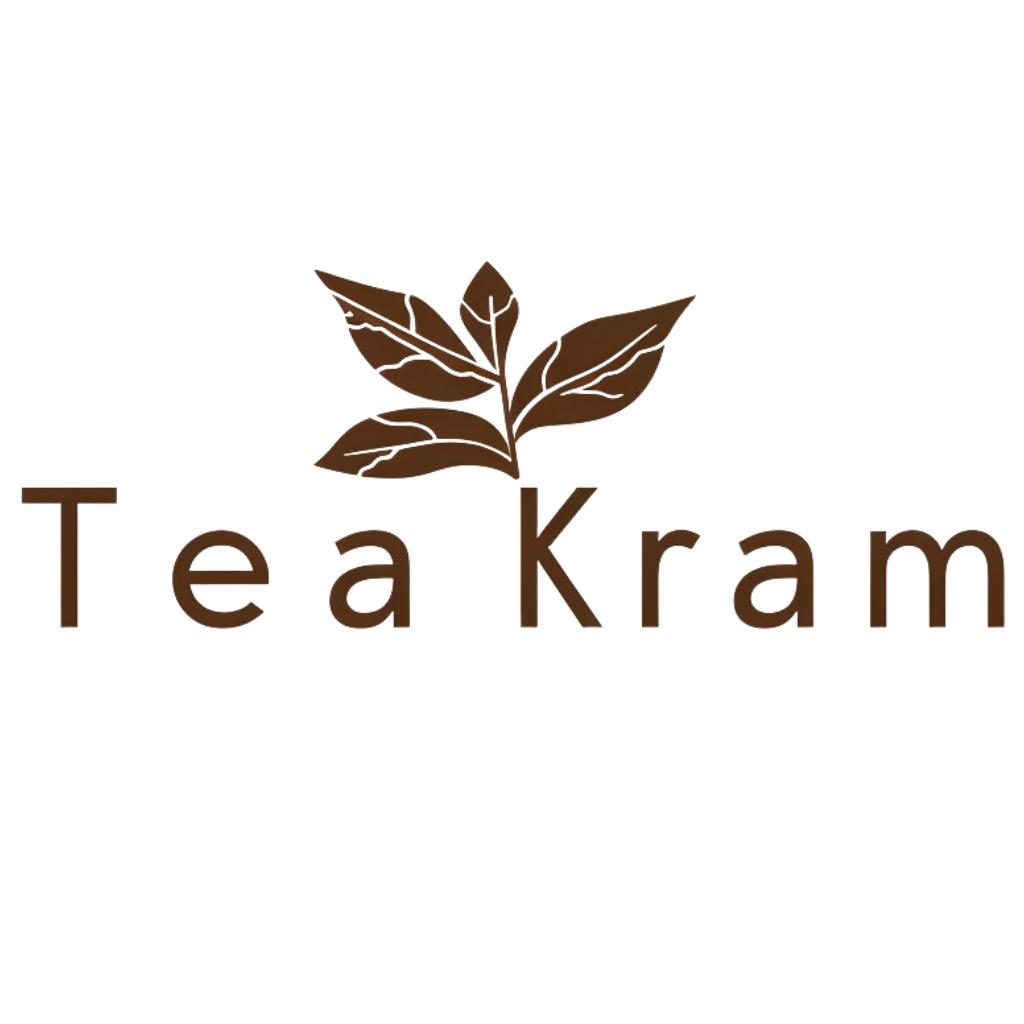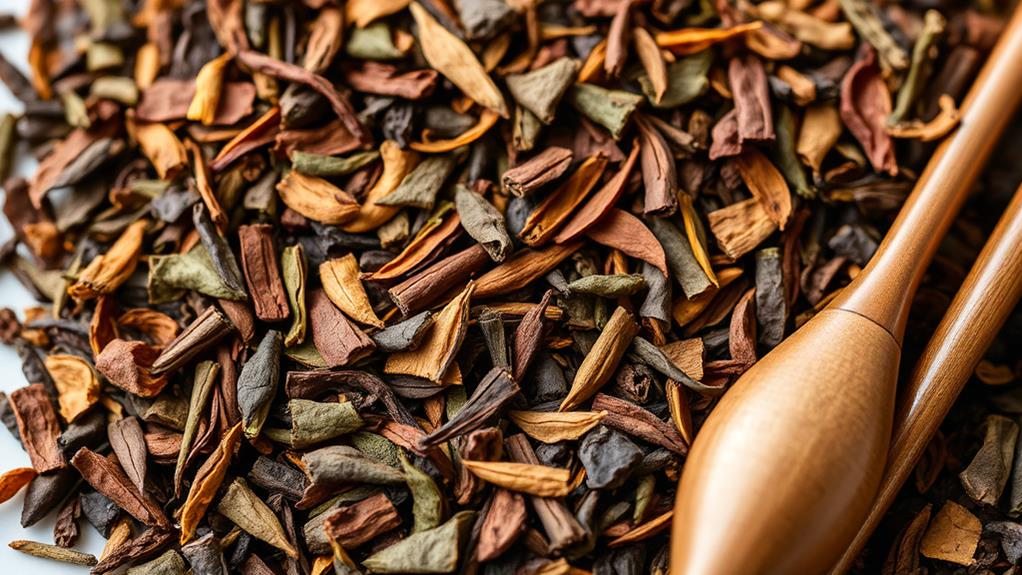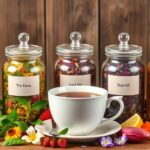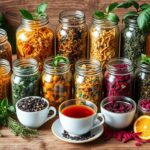Loose leaf tea is graded based on important characteristics like leaf appearance, aroma, and processing methods. You'll want to look for whole, unbroken leaves with vibrant colors, as these indicate quality. Aroma plays a big role too; fresh tea should smell inviting and strong. The processing methods also matter—steps like withering, rolling, and drying all impact flavor and quality. Different regions have unique grading systems, reflecting their local flavors. By keeping these factors in mind, you'll be well-equipped to pick high-quality loose leaf tea. There's a lot more to discover about tea's fascinating world ahead!
Understanding Tea Grading Systems
When you dive into the world of loose leaf tea, understanding the grading systems can seem daunting at first, but it's essential for appreciating quality. Grading standards help categorize tea based on its characteristics, allowing you to make informed choices. The most common tea classifications include grades like "Orange Pekoe," which refers to the size and quality of the leaf, and "Broken," indicating smaller leaves that often brew faster.
Additionally, different tea types, such as varieties and flavors, can also influence the grading, as certain types are valued more for their unique profiles.
You might wonder why grading matters. Simply put, higher grades typically mean better flavor and aroma. This isn't just a marketing gimmick; it reflects the care taken in cultivation and processing. For instance, a top-grade tea leaf often comes from the youngest buds, leading to a sweeter, more delicate taste.
As you explore various teas, you'll notice these classifications guide your palate. Don't shy away from asking questions about the grading systems when you're at a tea shop; it's a chance to learn more and discover unique blends.
Factors Influencing Tea Quality
When you're exploring tea quality, two big factors come into play: leaf appearance and size, along with aroma and flavor profile.
The way the leaves look and their size can tell you a lot about how fresh and tasty your tea will be. For instance, high-quality loose leaf tea often features whole, unbroken leaves, which can enhance the brewing process and flavor.
Additionally, the aroma and flavor are what really make your tea-drinking experience special, so paying attention to these elements can help you pick the perfect brew!
Leaf Appearance and Size
The appearance and size of tea leaves play a crucial role in determining their quality, often serving as a visual cue for enthusiasts. When you examine loose leaf tea, you'll notice that leaf texture and color variation are telling features. High-quality tea leaves typically possess a uniform appearance, free from stems and dust, which can indicate inferior grades.
Additionally, opting for loose leaf tea can reduce the environmental impact associated with single-use tea bags, contributing to a more sustainable choice for tea drinkers reduces contribution to landfill waste.
You might be surprised to learn that the size of the leaves matters, too. Larger leaves often suggest that the tea was harvested at the right time, allowing them to develop their full flavor potential. Conversely, smaller leaves can sometimes mean that the tea was picked too early or poorly processed.
As you explore different teas, look for vibrant colors that range from deep green to rich brown. These hues aren't just pretty; they signal freshness and proper processing.
Don't forget to feel the leaves! A smooth, supple texture often signifies quality, whereas brittle or overly dry leaves can lead to a lackluster brew.
Aroma and Flavor Profile
After considering the appearance and size of tea leaves, the next important aspect of loose leaf tea is its aroma and flavor profile. These elements are vital to the overall tea experience, and they can be influenced by various factors, including the type of tea, growing conditions, and brewing techniques. By understanding how to analyze these attributes through sensory analysis, you can elevate your tea-drinking experience.
Here's a quick overview of some common aroma and flavor profiles you might encounter:
| Aroma Profile | Flavor Profile | Brewing Technique |
|---|---|---|
| Floral | Sweet | Steep at lower temp |
| Earthy | Bold | Longer infusion time |
| Fruity | Crisp | Quick steeping |
| Nutty | Rich | Multiple infusions |
| Spicy | Complex | Varied temps |
As you explore different teas, experiment with brewing techniques to unlock their unique aromas and flavors. Pay attention to how each cup makes you feel. The right combination of aroma and flavor can transform a simple tea break into an innovative experience, sparking creativity and joy in your day. So, get brewing and enjoy the delightful world of loose leaf tea!
Leaf Appearance and Characteristics
A tea's leaf appearance and characteristics reveal much about its quality and flavor profile. When you look at loose leaf tea, pay attention to the leaf color. Vibrant green leaves often indicate freshness and a high-quality harvest, while dull or faded colors can suggest age or poor processing.
Additionally, the rich polyphenols and antioxidants found in high-quality teas contribute to their health benefits, making them a great choice for overall wellness and longevity exceptional health benefits. You'll also want to consider the shape and size of the leaves. Broken leaves may release flavor quickly but might lack the complexity of whole leaves, which can brew a more nuanced cup.
Another characteristic to observe is stem presence. While some stems can enhance the tea's flavor and provide a unique texture, an excessive number of stems might dilute the overall quality. Ideally, you want a balanced mix of leaves and buds, which signals a premium product.
As you explore different teas, remember that these visual cues can guide you toward discovering innovative flavors and experiences. By understanding leaf appearance and characteristics, you'll be better equipped to choose teas that align with your taste preferences.
Aroma and Fragrance Evaluation
When you're evaluating loose leaf tea, the aroma and fragrance can tell you a lot about its quality.
You'll want to use freshness assessment techniques to determine how recently the tea was processed, along with identifying key aroma profile characteristics that make each tea unique.
Plus, measuring fragrance intensity helps you understand just how bold or subtle those delightful scents really are!
Freshness Assessment Techniques
Evaluating the aroma and fragrance of loose leaf tea is crucial for determining its freshness. When you open a package of tea, take a moment to inhale deeply. Fresh tea should offer a vibrant and inviting scent, hinting at its quality and flavor. If the aroma is weak or stale, it could indicate poor storage conditions, which may affect the tea's shelf life.
Freshness plays a significant role in the overall health benefits of tea, as consuming vibrant, aromatic tea enhances the experience while providing key health benefits such as antioxidants and immune support.
To assess freshness, you can also perform a simple pinch test. Gently crush a few leaves between your fingers and smell them. The more fragrant they are, the fresher the tea!
Remember, optimal storage conditions are key to preserving that delightful aroma. Keep your tea in a cool, dry place, away from sunlight, moisture, and strong odors.
Additionally, consider the packaging. Vacuum-sealed bags or airtight containers can help maintain the tea's freshness for longer. If your tea's aroma doesn't excite you, it might be time to explore new options.
Embracing this sensory experience not only enhances your brewing ritual but also ensures you enjoy the best flavors possible. So, trust your nose and let it guide you to the freshest loose leaf tea!
Aroma Profile Characteristics
The aroma profile of loose leaf tea is a complex tapestry of scents that can reveal much about its origin and quality. When you inhale the fragrance, you're not just enjoying a pleasant smell; you're engaging with the tea's story. Aroma intensity and fragrance complexity play crucial roles in this experience.
To help you better understand these characteristics, consider the following table:
| Aroma Intensity | Fragrance Complexity | Examples |
|---|---|---|
| Subtle | Simple | Green tea, white tea |
| Moderate | Balanced | Oolong tea |
| Strong | Rich and layered | Black tea, flavored blends |
When you're evaluating a tea, notice how the aroma intensity can range from subtle to strong. A more complex fragrance often indicates a higher quality tea, as it suggests a variety of aromas harmonizing together. So, when you're selecting your next loose leaf tea, take a moment to appreciate its aroma profile. It's an exciting way to connect with the tea and decide which one truly speaks to you!
Fragrance Intensity Measurement
Measuring fragrance intensity in loose leaf tea involves a blend of objective assessment and personal perception. You'll find that scent intensity plays a crucial role in fragrance evaluation, helping you appreciate the tea's unique aroma.
To get started, take a moment to fully engage your senses and observe the fragrance before brewing.
Here's how you can enhance your fragrance evaluation experience:
- Inhale deeply: Take a moment to sniff the dry leaves, allowing the scent to envelop you.
- Compare aromas: Brew different teas side by side to notice the differences in their scent intensity.
- Use a scale: Rate the fragrance on a scale of 1 to 10, making it easier to remember your favorites.
- Take notes: Jot down your impressions; this will help you refine your taste over time.
Taste and Flavor Profile
When exploring loose leaf tea, you'll quickly discover that each variety offers a unique taste and flavor profile that can captivate your senses. The taste complexity of these teas is truly remarkable.
Imagine sipping a cup that starts with a bright, citrusy note and gradually unfolds into rich, earthy undertones. These flavor nuances are what set high-quality loose leaf tea apart from the rest.
As you dive deeper into the world of tea, you'll notice how different regions and types influence the overall experience. For instance, a delicate white tea may present floral hints, while a robust black tea can surprise you with hints of chocolate or spice.
Each sip can reveal layers of flavor, making your tea-drinking journey exciting and dynamic.
Experimenting with brewing times and temperatures can enhance these flavors even more. Don't be afraid to explore! Each cup is an opportunity to discover something new.
The Role of Processing Methods
Various processing methods play a crucial role in shaping the final characteristics of loose leaf tea.
These processing techniques can significantly influence the flavor, aroma, and overall quality of the tea you enjoy. Understanding how different methods impact your cup can help you appreciate the craft behind each blend.
Here are some key processing techniques that enhance quality:
- Withering: This removes excess moisture and prepares the leaves for further processing.
- Rolling: This step breaks the leaves' cell walls, releasing essential oils and enhancing flavor.
- Oxidation: Controlled exposure to air develops unique tastes and colors in the tea.
- Drying: This final step locks in flavors and prevents spoilage.
Each technique brings out distinct qualities, making it essential to know how they're applied.
For instance, a green tea undergoes minimal oxidation, preserving its fresh, grassy notes. In contrast, black tea is fully oxidized, resulting in a richer, bolder flavor.
By exploring these innovative processing methods, you can deepen your appreciation for loose leaf tea and discover which styles you love most.
Don't hesitate to experiment and find your perfect brew!
Regional Influences on Grading
Across the globe, regional influences play a significant role in how loose leaf tea is graded. Each area has its unique tea traditions, which shape not only the flavor profiles but also the grading standards.
For instance, in China, the focus is often on the appearance and aroma of the leaves. You might notice that teas from the Fujian province, like Tieguanyin, are graded based on their tightly rolled leaves and floral scent.
Meanwhile, Indian teas, especially those from Darjeeling, have their own grading system, emphasizing the tea's muscatel flavor and lightness.
When you dive into these regional tea traditions, you'll discover that they reflect local climates, soils, and cultivation methods. These factors influence how each tea is processed and ultimately graded.
For example, the grading of Japanese Sencha often highlights its vibrant green color and fresh taste, resulting from careful steaming techniques.
Understanding these regional influences not only enhances your appreciation of loose leaf tea but also helps you make informed choices.
Choosing Quality Loose Leaf Tea
To choose quality loose leaf tea, start by examining the appearance of the leaves. Look for whole, unbroken leaves with vibrant colors. Dull, crumbled leaves often indicate poor quality.
Next, consider the aroma; fresh, fragrant leaves promise a delightful brew.
Here are some tips to enhance your tea experience:
- Explore different brewing techniques: Experiment with water temperature and steeping times to find what brings out the best flavors.
- Store your tea wisely: Keep it in an airtight container, away from light and moisture. This preserves its freshness.
- Check for certifications: Look for organic or specialty labels that signify high-quality sourcing.
- Taste before you buy: If possible, sample the tea to ensure it matches your preferences.
Don't be afraid to try new blends! The world of loose leaf tea is vast and full of flavors waiting to be discovered.
FAQ
How Can I Tell if Loose Leaf Tea Is Fresh?
To tell if your loose leaf tea's fresh, assess its aroma and examine the leaf appearance. Fresh tea should emit a vibrant scent and have vibrant, intact leaves, signaling its quality and innovation in flavor.
What Storage Methods Help Maintain Tea Quality?
Picture your tea leaves nestled in an airtight container, shielded from light and moisture. This keeps oxidation levels low, preserving vibrant flavor profiles. Innovatively store them in a cool, dark place to savor every aromatic sip.
Are There Certifications for Organic or Fair-Trade Loose Leaf Tea?
Yes, there are certifications for organic and fair-trade loose leaf tea. You'll find certification processes that adhere to organic standards and fair trade criteria, ensuring proper labeling requirements for transparency and quality in your innovative choices.
Can I Use the Same Leaves for Multiple Brews?
Imagine a dance of flavors unfolding as you brew. Yes, you can reuse those leaves! Explore innovative brewing techniques to unlock hidden flavor profiles, revealing new depths in each cup, transforming ordinary moments into extraordinary experiences.
How Does Tea Grading Impact Price and Availability?
Tea grading directly influences pricing and availability. Higher grades fetch premium prices due to market demand, reflecting their quality and rarity. You'll find innovative blends and unique flavors, enhancing your tea experience while navigating this dynamic market.
Final Thoughts
Now that you know how loose leaf tea is graded for quality, imagine standing in a tea shop, surrounded by aromas that tease your senses. With each sip, you can appreciate the careful evaluation of leaf appearance, aroma, and taste that brings out the best in every cup. Next time you choose tea, remember the journey it took to reach your hands. Quality tea isn't just a drink; it's an experience waiting to unfold!



